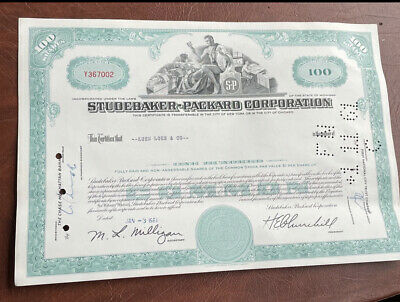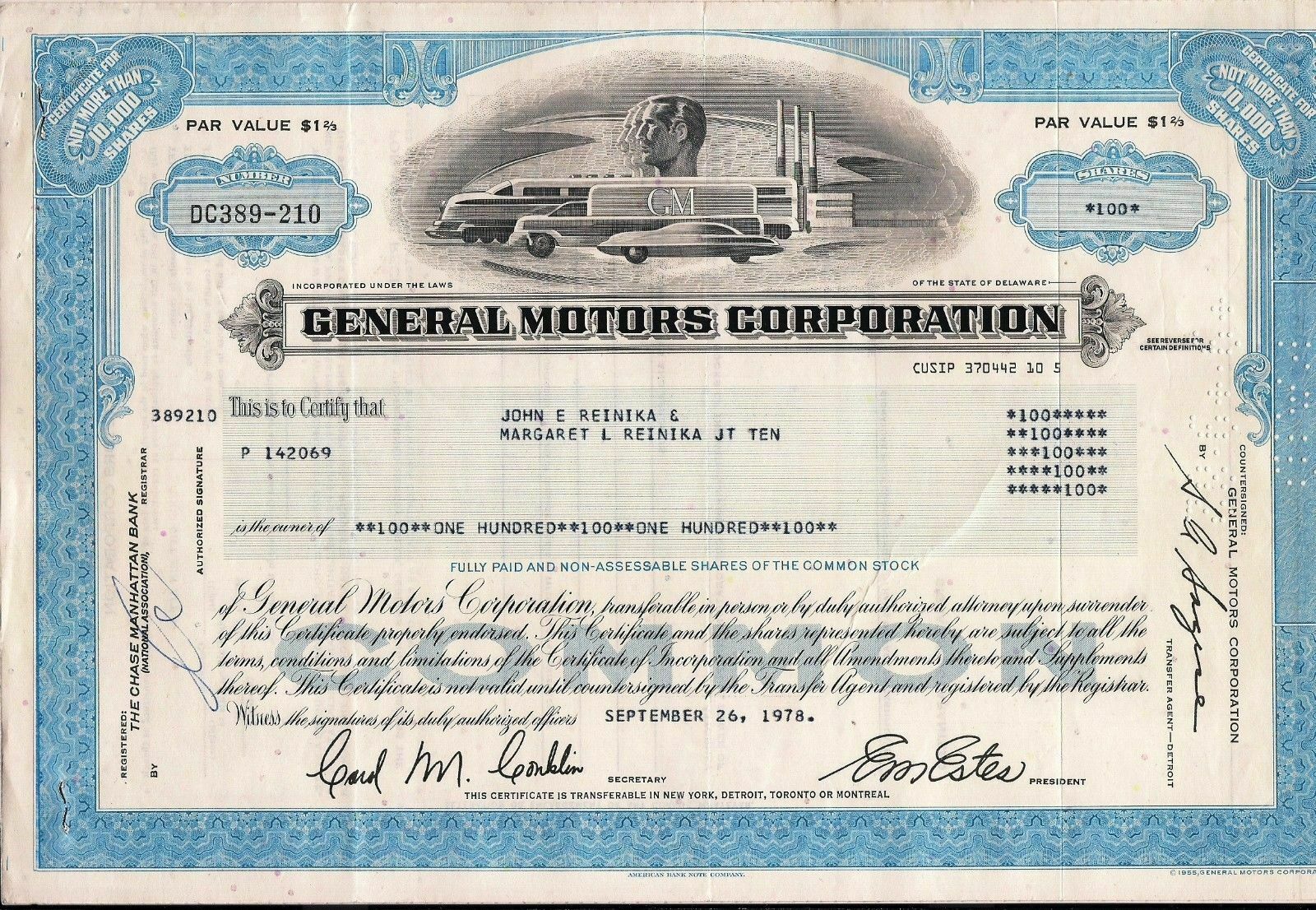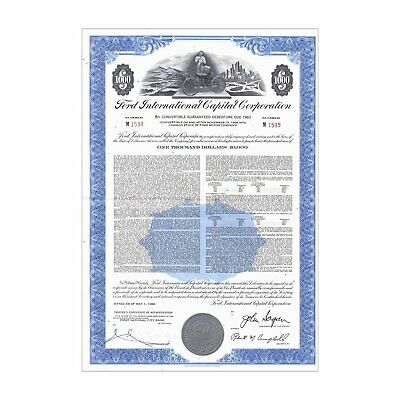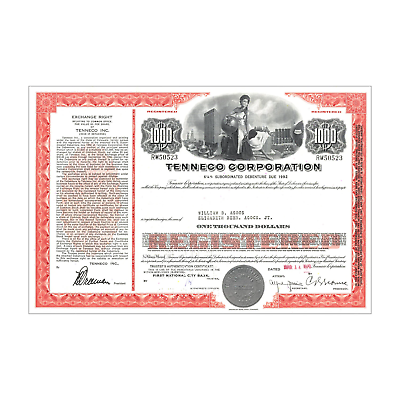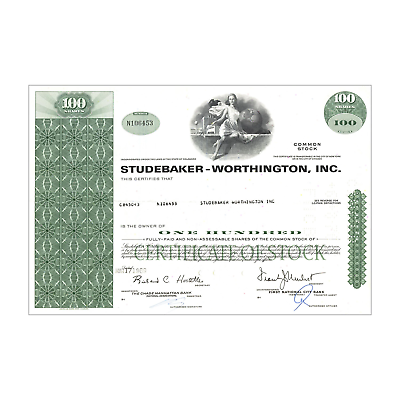-40%
Chrysler Financial Corporation Bond Certificate (Hood Ornament Vignette)
$ 3.69
- Description
- Size Guide
Description
Product DetailsNicely engraved antique bond certificate from the Chrysler Financial Corporation dating back to the 1970's and 1980's. This document, which carries the printed signatures of the company President and the Vice President/Treasurer, was printed by the Security-Columbian Bank Note Company, and measures approximately 12" (w) by 8" (h).
The certificate's detailed vignette features a pair of allegoricals flanking a Chrysler hood ornament. Two city scenes are in the background featuring a number of cars.
Great Chrysler collectible!
Images
You will receive the exact certificate pictured
.
Historical Context
Chrysler was founded by Walter P. Chrysler on June 6, 1925, when the Maxwell Motor Company was re-organized into the Chrysler Corporation.
Walter Chrysler had originally arrived at the ailing Maxwell-Chalmers company in the early 1920s, having been hired to take over and overhaul the company's troubled operations (just after having done a similar rescue job at the Willys car company).
In late 1923, production of the Chalmers automobile was ended.
Then in January 1924, Walter Chrysler launched the well-received Chrysler automobile. The Chrysler was a 6-cylinder automobile, designed to provide customers with an advanced, well-engineered car, but at a more affordable price than they might expect. (Elements of this car are traceable back to a prototype which had been under development at Willys at the time that Walter Chrysler was there).
The Maxwell was then dropped after its 1925 model year run, although in truth the new line of lower-priced 4-cylinder Chryslers which were then introduced for 1926 were basically Maxwells which had been re-engineered and rebranded.
It was during this period that Walter Chrysler assumed the presidency of the company, with the company then ultimately incorporated under the Chrysler name.
In 1928, the Chrysler Corporation founded the Plymouth brand at the low priced end of the market (essentially by once again re-engineering and rebranding the 4-cylinder models), and it also introduced the DeSoto brand in the medium price field. Subsequently, Chrysler acquired the Dodge Brothers automobile company; all of this was in order to set up a full range of brands similar to that of the General Motors corporation. This process reached its logical conclusion in 1955, when the Imperial was made a brand of its own and Chrysler marketed a GM-like five-brand lineup. Well before then, though, Chrysler Corporation had become noted both for its engineering features as well as its periodic financial crises. By the end of the 1930s, the DeSoto and Dodge divisions would flip-flop spots in the corporate pecking order making the lineup Plymouth, Dodge, DeSoto, Chrysler, and Imperial.
In 1934, the company introduced the Chrysler Airflow, featuring an advanced streamlined body which was among the first to be designed according to scientific aerodynamic principles. Chrysler also created the industry's first wind tunnel to develop them. Unfortunately, it was not well accepted by the public, and it was the humble Dodge and Plymouth divisions, which had not been given an Airflow model, which pulled the firm through the Depression years with its conventional but quite popular body styles. Plymouth was one of only a few marque that actually increased sales during the cash-strapped thirties. It was during this decade that the company created a formal parts division under the Mopar (Motor Parts) brand, with the result that Chrysler products are still often called Mopars.
The unsuccessful Airflow had a chilling effect on Chrysler styling and marketing, which remained determinedly unadventurous through the 1940s and into the 1950s, with the single exception of the installation of hidden headlights on the very brief production run of the 1942 DeSotos. Engineering advances continued however, and in 1951, the firm introduced the first of a long and famous series of Hemi V8s. In 1955, things brightened after the stodgy post-war styling with the introduction of Virgil Exner's successful Forward Look designs. With the inauguration of the second generation Forward Look cars for 1957, "Torsion-Aire" was introduced. This was not air suspension, but an indirect-acting, torsion-spring front suspension system which drastically reduced unsprung weight and shifted the car's center of gravity downward and rearward. This resulted in both a smoother ride and significantly improved handling. However, a rush to production of the 1957 models led to quality-control problems (mostly related to body fit and finish, resulting in major rusting). This, coupled with a national recession, found the company again in recovery mode.
Starting in the 1960 model year, Chrysler built all their passenger cars (excluding Imperials through 1966) with Unibody™ (unit-body or monocoque) construction. Chrysler thus became the only one of the Big Three American automakers (General Motors Corporation, Ford Motor Company, and Chrysler) to offer unibody construction on the vast majority of their product lines. This construction technique, which has since become the worldwide industry standard, offers advantages in vehicle rigidity, handling, and crash safety, while reducing the tendency for squeaks and rattles to develop as the vehicle ages. Chrysler's new compact line, the Valiant, opened strong and continued to gain market share for well over a decade. Valiant was introduced as a division of its own but would become adopted by Plymouth in 1961. The 1960 Valiant was the first production automobile with an Alternator rather than a electrical generator as standard equipment; it proved such a significant improvement that its use was expanded to all Chrysler products for 1961. The DeSoto marque was withdrawn from the market after the introduction of the 1961 models due in part to the broad array of the Dodge lines and the general neglect of the division. The same affliction plagued Plymouth as it also suffered when Dodge crept into Plymouth's price range. This would eventually lead to the demise of Plymouth several decades down the road. An ill-advised downsizing of the full-size Dodge and Plymouth lines in 1962 hurt sales and profitability for several years.
In April 1964, the Plymouth Barracuda, which was a Valiant sub-model, was introduced. The huge glass rear window and sloping roof were polarizing styling features. Barracuda was released almost two weeks before Ford's Mustang, and so the Barracuda was really the first pony car. However, unlike the Mustang, Barracuda did not rob sales of other division's models. In spite of Barracuda's generally acknowledged better build quality, handling, braking and performance than the Mustang, the Mustang still outsold the Barracuda 10-to-1 between April 1964 and August 1965.
In the 1960s Chrysler expanded into Europe, attaining a majority interest in the British Rootes Group in 1964, Simca of France and Barreiros of Spain, to form Chrysler Europe. For the Rootes Group one outcome of this take over was the launch of the Hillman Avenger in 1970 (briefly sold in the US as the Plymouth Cricket), which sold in Britain alongside the rear-engined Imp and the Hunter. Due to the industrial unrest that was rife in Britain during the 1970s the former Rootes Group got into severe financial difficulties. The Simca and Barreiros divisions were more successful, but in the end the various problems were overwhelming and the firm gained little from these ventures. Chrysler sold in 1978 these assets to PSA Peugeot Citroën, which in turn sold quickly the British and Spanish truck production lines to Renault of France.
More successfully, at this same time the company helped create the muscle car market in the U.S., first by producing a street version of its Hemi racing engine and then by introducing a legendary string of affordable but high-performance vehicles such as the Plymouth GTX, Plymouth Road Runner, and Dodge Charger. The racing success of several of these models on the NASCAR circuit burnished the company's reputation for engineering.
The 1970s brought both success and crisis. The aging but stalwart compacts saw a rush of sales as demand for smaller cars crested after the first gas crisis of 1973. However, an expensive investment in an all-new full-size lineup went largely to waste as the new 1974 vehicles appeared almost precisely as gasoline prices reached a peak and large-car sales collapsed. 1974 would also mark the end of the Barracuda (and the similar Dodge Challenger) after the redesigned ponycars introduced for 1970 had failed to attract buyers in the shrinking market segment. At mid-decade, the company scored a conspicuous success with its first entry in the personal luxury car market, the Chrysler Cordoba. However, the introduction of the Dodge Aspen/Plymouth Volare twins in 1976 did not repeat the success of the discontinued Valiant/Dodge Dart line, and the company had delayed in producing a domestic entry in the now important subcompact market. Problems were multiplying abroad as well, as Chrysler Europe essentially collapsed in 1977. It was offloaded to Peugeot the following year, ironically just after having helped design the new Plymouth Horizon and Dodge Omni, on which the increasingly-desperate company was pinning its hopes. Shortly thereafter, Chrysler Australia, which was now producing a rebadged Japanese Mitsubishi Galant, was sold to Mitsubishi Motors. The subcompact Horizon was just beginning to reach the U.S. market when the second gas crisis struck, devastating sales of Chrysler's larger cars and trucks, and the company had no strong compact line to fall back on. Later the Horizon was also produced and developed in Finland and marketed in Scandinavia as Talbot Horizon. After the Peugeot bought Talbot and the new version of Horizon was named as Peugeot 309.
In desperation, the Chrysler Corporation on September 7, 1979 petitioned the United States government for .5 billion in loan guarantees to avoid bankruptcy. At the same time, Lee Iacocca, a former Ford executive, was brought in to take the position of CEO, and proved a capable public spokesman for the firm, regularly appearing in advertisements to advise customers that "If you find a better car, buy it." He would also provide a rallying point for Japan-bashing and instilling pride in American products. His book, Talking Straight was a fitting reply to Akio Morita's Made in Japan. A somewhat reluctant Congress passed the "Chrysler Corporation Loan Guarantee Act of 1979" (Public Law 96-185) on December 20, 1979 (signed into law by President Jimmy Carter on January 7, 1980), prodded by Chrysler workers and dealers in every congressional district who feared the loss of their livelihoods. With such help and a few innovative cars (such as the K-car platform), especially the invention of the minivan concept, a market where Chrysler brands are still important, Chrysler avoided bankruptcy and slowly fought its way back.
In February 1982 Chrysler announced the sale of Chrysler Defense Inc., its profitable defense subsidiary to General Dynamics for 8.5 million. The sale was completed in March 1982 for the revised figure of 6.1 million.
By the early 1980s, the loans were being repaid at a brisk pace and new models based on the K-car platform were selling well. A joint venture with Mitsubishi called Diamond Star Motors strengthened the company's hand in the small-car market. Chrysler acquired AMC in 1987, mostly for its Jeep brand although the failing Eagle Premier would be the basis for the later Chrysler LH platform sedans. This bolstered the firm further, although Chrysler was still the weakest of the Big Three. In the early 1990s, Chrysler made its first tentative steps back into Europe, setting up car production in Austria, and beginning right-hand drive manufacture of certain Jeep models in a 1993 return to the UK market. The continuing popularity of Jeep, bold new models for the domestic market such as the Dodge Ram pickup, Dodge Viper (badged as "Chrysler Viper" in Europe) sports car, and Plymouth Prowler hot rod, and new "cab forward" front-wheel drive sedans put the company in a strong position as the decade waned.
In 1998 Daimler-Benz purchased Chrysler, forming DaimlerChrysler AG. Chrysler Corporation then was legally renamed DaimlerChrysler Motors Company LLC, while its total operations began doing business as Chrysler Group. This was initially declared to be a “merger of equals,” but it quickly became evident that Daimler-Benz was the dominant partner. Chrysler went into another of its financial tailspins soon after the merger, greatly depressing the stock price of the merged firm and causing serious alarm at headquarters in Germany, which sent a new CEO, Dieter Zetsche, to take charge in Auburn Hills. The Plymouth brand was phased out in 2001, and plans for cost-cutting by sharing of platforms and components began. The strongly-Mercedes-influenced Chrysler Crossfire was one of the first results of this program. A return to rear-wheel drive was announced, and in 2004, a new Chrysler 300 using this technology and a new Hemi V8 appeared and became a solid hit. Financial performance began to improve somewhat, with Chrysler now providing a significant share of DaimlerChrysler profits due to restructuring efforts at the Mercedes Car Group. The long-standing partnership with Mitsubishi was dissolved as DaimlerChrysler divested its stake in the firm due to diving Mitsubishi profits and sales worldwide.


